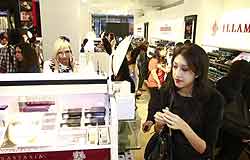 |
| Getty Images |
Companies like Procter & Gamble Co., Clorox Co. and L'Oreal SA are launching growing numbers of over-the-counter products targeted at adults with acne. And dermatologists say they are seeing more adults seeking treatment for the condition, especially women between the ages of 20 and 40. One result: more creams that treat both wrinkles and pimples.
Acne is often particularly distressing to adults, "because the perception is that we should be getting over it," says Rachel Herschenfeld, a dermatologist in Wellesley, Mass. "The reality is that some people don't. The even harsher reality is that some adults develop acne even if they didn't have it as a teenager."
In a 2008 survey of 1,013 people, 51% of women reported having acne in their 20s, while 35% had it in their 30s. The survey, published in the Journal of the American Academy of Dermatology, found lower occurrences in men—43% and 20%.
One reason may be stress, which can exacerbate breakouts in people prone to acne. "Women in general probably have more stressful, high-paced lives than they did a generation or two ago," says Diane Berson, a dermatologist in New York who consults for brands such as P&G and L'Oréal.
More from Wall Street Journal: |
While teens break out all over their faces, especially in the "T-zone"—the forehead, nose and chin—dermatologists say, adult women who get acne tend to get a few deep blemishes in the lower region of the face, mainly the chin.
The growth in the number of adult acne patients presents an opportunity for the skin-care industry. "The psychology of something like acne is if you have tried everything and nothing works and it's important to you, then you will pay whatever it takes to get rid of it," says Diane Miles, chief executive of Perricone MD. The high-end skin-care company is focused on anti-aging treatments but carries a line of acne products.
But the rest of the product often is different. Acne treatments for older people are gentler and less drying, and many contain ingredients that combat wrinkles and promote skin health. These products are also more expensive, ranging from less than $10 to more than $60.
At Sephora, which is rolling out several of its own acne products this year, the typical skin-care client "is willing to spend a bit more money" than a makeup shopper, says Carolyn Bojanowski, director of skin care. Shoppers also expect more out of skin products these days. "It's got to hit everything from acne to spots to fine lines," she says.
The new Effaclar Duo Dual Action Acne Treatment from L'Oréal's La Roche-Posay, for instance, contains not only benzoyl peroxide but also lipo-hydroxy acid, which scrubs away dead skin cells. The suggested retail price: $35.95.
Gentler treatments became popular with the launch of Proactiv Solution, a skin-care system introduced by direct marketer Guthy-Renker in 1995. While most treatments on the market contained benzoyl peroxide levels of 10%, Proactiv's creators decided to use a 2.5% concentration so that the products weren't as harsh on female skin.
"We took the concept of low-strength medicine and married it with skin care so that people would use it every day," says Katie Rodan, co-inventor of Proactiv and an adjunct associate clinical professor of dermatology at Stanford University. Dr. Rodan says Proactiv's three-step system was tailored to adult women.
More companies are introducing multistep skin-care systems for acne-prone skin. P&G this July is launching Olay Professional Pro-X Clear, a new skin-care line the company says is specifically designed for adult skin. The consumer products giant says its three-step system—which includes a clarifying cleanser, skin-clearing treatment and moisturizer—controls acne while improving the skin's appearance. The system, called Pro-X Clear Acne Protocol, has a suggested retail price of $42.
While three-step kits aren't necessarily better for the skin than products from various makers, kits can "increase compliance" among patients following a skin-care regimen, says Amy Derick, a dermatologist in Barrington, Ill.
 |
| Courtesy of Murad |
Skin-care companies are offering acne products with aging benefits at both drugstores and department stores. Johnson & Johnson's Neutrogena offers a Healthy Skin Anti-Wrinkle Anti-Blemish Cream for $13 that contains salicylic acid to fight acne and retinol to fight wrinkles.
Again, with the industry in flux and tablets on the rise, if you can wait to buy a laptop, do so. But if you must take the plunge, don't buy more laptop than you need.
Murad Inc. launched its Anti-Aging Acne line in 2009, including ingredients like amino acids to tackle wrinkles and fine lines. The company will release a new Anti-Aging Acne kit at Sephora this month, priced at $45.
"It has to be a different product from what we give a teenager," says Howard Murad, chief executive and founder of the Los Angeles-based skin-care company.
Others are coming out with treatments that reduce scars and acne-related dark spots, which can be hard to treat in older people. Estée Lauder Cos.' Clinique brand says one item it calls Even Better Clinical Dark Spot Corrector, introduced last year, promises results comparable to prescription ingredients.
For the year ended April 17, sales of acne products at supermarkets, drugstores and mass-market retailers, excluding Wal-Mart, were $386.8 million, up 3% from the year earlier, according to SymphonyIRI Group, a market-research firm in Chicago.
Dermatologists say over-the-counter treatments can be effective. But patients should take their skin types into account. Some people, for instance, are sensitive to benzoyl peroxide and may find it drying. And those who suffer severe acne or can't get results from over-the-counter products should turn to a doctor, who can prescribe stronger products.
"With adult female acne, it ends up being deeper in the skin, so it's not a surface problem," says Dr. Derick.
Posting source: http://shopping.yahoo.com/articles/yshoppingarticles/617/fighting-pimples-and-wrinkles-at-the-same-time/

No comments:
Post a Comment